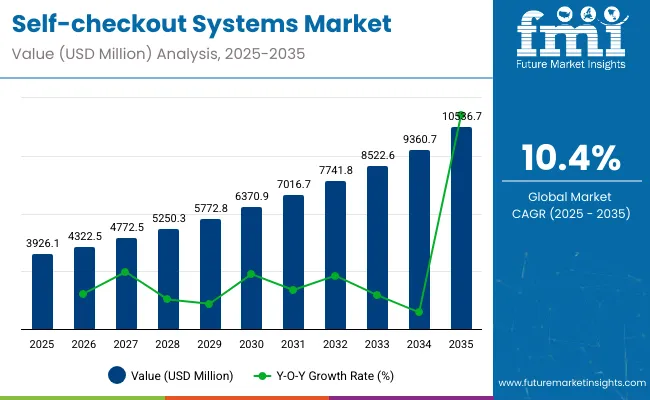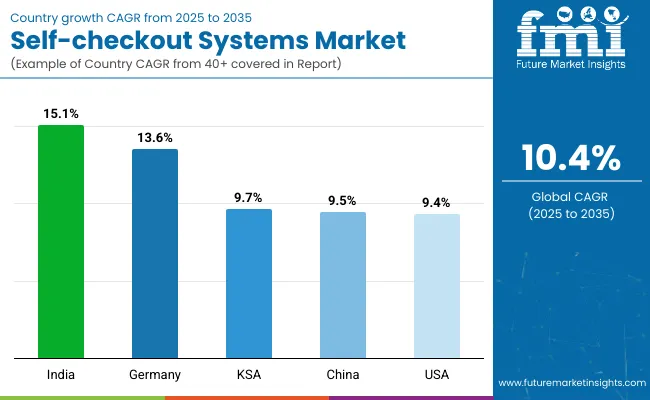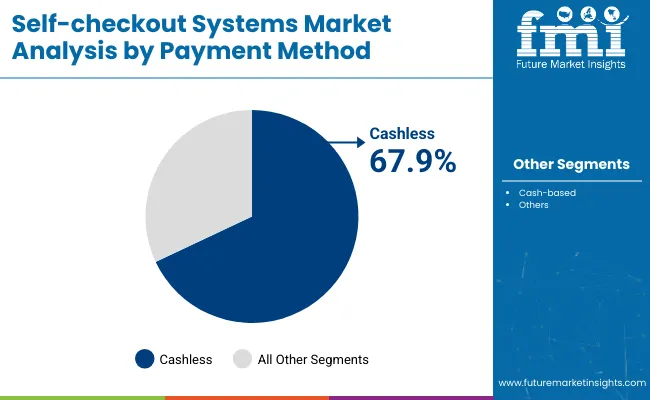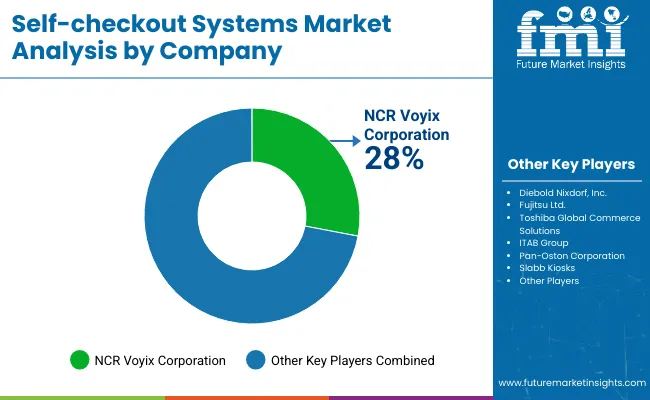The global self-checkout systems market is expected to reach USD 3,926.1 million in 2025. Demand for self-checkout systems is projected to rise at a CAGR of 10.4% from 2025 to 2035. Additionally, the self-checkout systems market analysis forecasts the market to surge to USD 10,536.7 million by the end of the year 2035.
Self-checkout systems are increasingly being adopted by retailers in the interest of efficiency, reduction of labor costs, and increasing shopper convenience. During a self-service checkout, customers can scan, bag, and pay for items themselves, minimizing wait times by hurrying up the checkout process.
Businesses are making the floor space smooth and decreasing the dependency on staff through the integration of self-service kiosks for checkouts, hence faster checkouts and smoothing the flow of operations.
Companies also integrate AI, machine vision, and biometric authentication to have better security against thefts. Supermarket chains, convenience stores, and quick-service restaurants function with great efficiency in very heavy footfalls using these systems.
Increased demand for touchless payment options drove more takers of the self-checkout technology for seamless and hygiene-specific transactions of customers. As automation reshapes retail, businesses are expanding self-checkout deployments to improve efficiency, enhance customer experience, and meet evolving market demands.

| Attributes | Key Insights |
|---|---|
| Estimated Size, 2025 | USD 3,926.1 million |
| Projected Size, 2035 | USD 10,536.7 million |
| Value-based CAGR (2025 to 2035) | 10.4% |
Manufacturers are equipping self-checkout systems with barcode scanning, touchscreen interface, weight sensors, AI-powered fraud detection, and integration with mobile payments. Other models boast RFID scanning, facial recognition, and voice assistants for a secure and smooth experience. In developing multi-item scanning and automated bagging features, retailers use them to speed up transactions, while AI-led loss prevention tools reinforce potential fallacies and thefts.
The use of self-checkout systems reduces queues and enables labor cost economies in a range of outlets: supermarkets, convenience stores, and retail chains. Quick-service restaurants and cafes are introducing kiosks to improve the speed of order processing. Airports, transportation hubs, and places of entertainment are installing kiosks for ticketing and self-check-in, adding customer convenience.
Kiosks for self-checkout technology are being introduced in different pharmacies and health facilities for over-the-counter medicine sales, making such transactions easier. As businesses are in need of more automation, they continue to adopt self-checkout solutions to improve efficiency and enhance customer satisfaction across various industries.
Several major companies are incorporating smart technologies into self-checkout systems to enhance efficiency, reduce wait times, and improve the overall retail experience. These technologies include AI-driven vision systems, weight sensors, RFID, and integrated mobile payment solutions.
Government regulations in the self-checkout systems market primarily focus on consumer rights, data privacy, accessibility, and payment compliance. As these systems handle sensitive data and financial transactions, regulatory oversight is increasing to ensure safe and inclusive usage.
The below table shows the expected CAGR for the global self-checkout systems market over few semi-annual periods, which covers 2025 to 2035. In the first half H1 over the years from 2024 to 2034, the business is predicted to surge at a CAGR of 10.5%, followed by a marginally higher growth rate of 10.2% in the second half H2 of the same decade.
| Particular | Value CAGR |
|---|---|
| H1 2024 | 10.5% (2024 to 2034) |
| H2 2024 | 10.2% (2024 to 2034) |
| H1 2025 | 10.2% (2025 to 2035) |
| H2 2025 | 10.6% (2025 to 2035) |
Moving into the subsequent period, from H1 2025 to H2 2035, the CAGR is projected to increase considerable to 10.2% in the first half and remain relatively moderate at 10.6% in the second half. In the first half H1 the market showcased a decrease of 30 BPS while in the second half H2, the market witnessed an increase of 40 BPS.
While consumers increasingly favor digital payment modes, retailers are including self-checkout systems that operate with most cashless solutions, including credit/debit cards, mobile wallets, and contactless payments. This is best observed with the rise of Apple Pay and Google Wallet that have become a part of consumer’s daily transactions.
The growing demand for modern store setups across developing countries is projected to benefit the industry in the forecasting period. The market has experienced the deployment of these systems in various industries, such as entertainment, healthcare, retail, and financial services, among others.
Retailers like Walmart, Kroger, and Family Mart are putting a lot of money into self-checkout systems technologies to meet customer needs and cut down on labor expenses. For example, NCR Corporation, a top company in self-checkout systems, keeps growing as it brings its new solutions to big international retailers. Other competitors, such as Toshiba, install hybrid kiosks to give more flexibility at the checkout.
Emergence of AI-driven systems of firms such as Mashgin represents another aspect by which retailers introduce systems in response to consumer’s demand for increased speed and convenience of shopping. Moreover, the rise in cashless transactions and value-added features, such as multi-item scanning and additional security machines, are also boosting this industry.
Self-checkout systems have reached a very high level of penetration in markets like North America and are growing at rapid speed in Asia-Pacific through the newly rapid growth in the number of retail outlets and demand for efficient store operations.
Technical issues and losses of connection are the main issues affecting the self-checkout systems market with recent events providing examples of it. In March 2024, Walmart faced a major issue when its self-checkout systems failed to update price data at 1,600 stores, leading to customers being overcharged or undercharged.
It took several days for the bank to rectify the glitch that caused them to lose millions of pounds worth of transactions as well as having to embark on a huge reimbursement operation. Not only did it anger customers, but it also cast doubt on the use of such systems in high throughput retail outlets.
Therefore, the management of a large volume of data generated in self-checkout systems has become a problem of performance, as it was seen in the quick-service restaurant industry, where unplanned downtime may cause severe operational interruption and a loss of sales.
Such challenges explain why technical platform and advanced monitoring capabilities must be employed to avoid and reclaim from such instances. Even so, the risks of self-checkout glitches are growing familiar to retailers, many of whom are beginning to develop countermeasures, and the effects remain a major issue in the continuous deployment of self-checkout technology.
The integration of self-checkout systems with blockchain can provide increased security, audit trail and faster completion of the transaction process. Since blockchain technology decentralizes the system, every single transaction done is documented thus, eliminating the possibilities of fraud and making users to be trustworthy of the organization. This feature is even more appealing particularly in retail industry where security of business and data integrity are critical.
On the other hand, blockchain can simplify payment processes because of the application of cryptocurrencies which will enhance consumer attraction especially the tech-powered customers and those in regions with unstable currencies.
The technology also makes it possible to implement smart contracts for enforcing the terms of sale, a refund, loyalty programs, among others, without necessarily involving a third-party. This may result in shortened transaction durations, issues such as charges being reduced and overall business productivity.
The global self-checkout systems industry witnessed a CAGR of 9.8% during the historical period between 2020 and 2024. During Covid-19, the adoption of self-checkout systems rapidly accelerated as the retailers needed to reduce the physical contact as much as possible. Consumers also preferred using these systems due to coronavirus fears. Not only retail sector, but other sectors such as quick-service restaurants also deployed the systems rapidly.
On the other hand, the market is estimated to grow at a CAGR of 10.4% during the forecasted period between 2025 and 2035. The market is expected to grow swiftly as it has a potential to reach a value of USD 10,536.7 million in 2035 from USD 3,926.1 million in 2025.
The demand for self-checkout systems is expected to continue growing owing to the more and more preference of consumers towards these systems due to convenience, less physical contact and payment method options.
Tier 1 companies includes companies that are performing as market leader in the self-checkout systems market. These companies are well-known brands with a broad customer base across various industries. These top vendors provide fully automated solution and integration capabilities with artificial intelligence. The companies in the bracket includes such as Diebold Nixdorf, Inc., NCR Voyix Corporation, Toshiba Global Commerce Solutions, Fujitsu Ltd, ITAB Group.
Tier 2 companies consists of the companies with growing customer base with a focus on innovation and customer service. These companies focuses on developing deep domain expertise to tailor solutions to the unique needs of their target markets. The companies in the tier are StrongPoint, Gilbarco Veeder-Root Company and others.
Tier 3 companies are the companies which are still trying to achieve stability in the market or these companies might be established recently. These companies are primarily focuses on partnerships and innovate highly specialized solutions. The companies in the tier include ECR Software Corporation, Pan-Oston Corporation and others.
The section below includes the industry analysis of self-checkout systems market over the countries in North America, Latin America, East Asia, South Asia & Pacific, Western Europe, Eastern Europe and Middle East & Africa. The analysis describes the country wise analysis that are expected to grow at a high CAGR.

| Countries | Value CAGR (2025 to 2035) |
|---|---|
| USA | 9.4% |
| KSA | 9.7% |
| Germany | 13.6% |
| India | 15.1% |
| China | 9.5% |
Digitalization, cost of labor and changing customer trends are few of the factors that are driving the market growth in Germany. As German retailers pay more attention towards optimization of operational costs and efficiency, the use of self-checkout systems has gained attraction. This trend expanded rapidly during the pandemic, and people have become ready to choose contactless, self-service and thus less time-consuming solutions.
For instance, following the year 2021, some of the biggest supermarket chains of Germany such as EDEKA and REWE are increasingly employing numerous self-checkout points. Likewise, in response to the crows in its stores, IKEA Germany expanded the number of self-checkout solution to streamline customer flow and increase IKEA Germany stores efficiency.
Such strategies are characteristic of the overall trends in the country toward the application of innovative solutions in the retail industry to enhance consumer’s satisfaction and to maximize business performance, hence making Germany one of the most promising markets for development of self-checkout systems.
With the increase of the growth in operations in organized retail store formats such as Reliance Retail, Big Bazaar etc. the use of the self-checkout systems has increased as it serves the purpose of improving efficiency of the stores. Also, the COVID-19 led to an increase in the adoption of contactless methods of shopping since it provided safety to shoppers as well as save on the time required to queue up for checkout.
Besides, the Indian population is young and fluent in technology transactions, making it ideal for NOCs with self-checking systems. The administration and its campaign for the transition to a digital economy, as evidenced by the Digital India movement, has also made possible the interaction between the use of digital payment systems in relation to self-checkout systems.
For instance, in 2021, Self-checkout started in the country’s two biggest store formats being Reliance Retail; Travis Future Store in Mumbai and Spencer Retail, Easy Day, in Bengaluru. Similarly, entrants such as Amazon India incorporated the “Just Walk Out” technology in some of the outlets where buyers could check themselves out without the help of cashiers. These development show the increased trend of self-checkout systems in India by combining technology advancement and customer preference.
The Chinese government has created a favorable environment for digital infrastructure through its strong backing of digital infrastructure such as the widespread use of mobile payment solutions such as Alipay and WeChat Pay for retail purchases. Also due to high populations in urban areas in China, self-checkout systems help in cutting down time and improve on the customer experience.
For instance, JD.COM, one of China’s largest e-commerce sites added numerous new units of unmanned retail stores that use facial recognition and other artificial intelligence technologies to enable shoppers to pay for goods independently, through self-operated value-added services.
Likewise, Alibaba Freshippo grocery stores integrated advance self-checkout technologies, combining facial recognition and mobile payments to streamline the shopping experience. These trends show the increasing use of self-checkout systems in China due to the need for fast and steady checkouts as well as China being at the forefront in the use of digital payment technologies.
Stationary self-checkout systems are in high demand due to their efficiency, space optimization, and ability to streamline customer experiences in high-traffic retail environments. These systems allow shoppers to scan, bag, and pay for items without cashier assistance, significantly reducing wait times and improving store throughput during peak hours.
Retailers benefit from reduced labor costs and better allocation of staff to other service areas, while also enhancing customer satisfaction through faster transactions.Stationary self-checkouts are especially favored in supermarkets, convenience stores, and department stores where consistent volume and checkout speed are critical. They are also equipped with advanced features like weight sensors, payment integration, and security alerts, ensuring smooth and secure operations.

| Component | Value Share (2035) |
|---|---|
| Stationary Self-Checkout Systems | 58.4% |
Cashless mode is common in self-checkout systems because it offers speed, convenience, and aligns with modern consumer payment habits. Digital payments using credit or debit cards, mobile wallets, and QR codes make transactions quicker, helping to reduce queues and improve customer flow in retail environments.
For businesses, cashless systems reduce risks associated with theft, minimize errors in handling physical cash, and lower operational burdens such as cash counting and storage. The growing popularity of smartphones and contactless payments has made cashless checkouts more accessible and preferred.

| Application | Value Share (2025) |
|---|---|
| Cashless Self-checkout Systems | 67.9% |

In February 2024, Aldi came into a partnership with Grabango to install its first fully automated checkout systems in USA The system was installed at a store in Chicago, allowing consumers to leave without scanning their items. The checkout equipment uses computer vision-based cameras and sensors attached on the ceiling to monitor shoppers as they walk through the store and records the items they select.
In January 2024, the company launched a new artificial intelligence (AI)-based checkout solution to combat shrinkage in the retail industry. The new Vynamic Smart Vision I Shrink Reduction manages the risk of shrink at self-checkout stations while ensuring positive shopper and employee experiences.
In January 2023, Toshiba Global Commerce Solutions, formed partnership with fintech startup PoPID to integrate PopPay into Toshiba's self-service solution powered by its ELERA Commerce Platform.
PopPay leverages artificial intelligence-based facial verification software to let users verify their identity for payments and/or loyalty. The restaurant, quick service restaurant (QSR), convenience stores (C-store), supermarket, and other retail segments received the integrated solutions from Toshiba.
In terms of product type, the industry is segmented into Portable Self-Checkout Devices and Stationary Self-Checkout Kiosks.
In terms of payment method, the industry is segregated into Cash-based Self-Checkout Systems and Cashless Self-Checkout Systems.
The sourcing channel is classified by Supermarkets, Department Stores, Convenience Stores, Pharmacies, Fast Food Restaurants, Airport Retail, Entertainment Venues and Others.
The end use is classified by Product Manufacturers (Direct), Leasing or Rental, Integration Partners and Others.
Key countries of North America, Latin America, East Asia, South Asia & Pacific, Western Europe, Eastern Europe and Middle East and Africa (MEA) have been covered in the report.
The market is valued at USD 3,926.1 million in 2025.
The market is slated to reach USD 10,536.7 million by 2035.
The market is set to grow at 10.4% CAGR during the study period.
Major companies include Diebold Nixdorf, Inc., NCR Voyix Corporation, Fujitsu Ltd., Toshiba Global Commerce Solutions, and ECR Software Corporation.
Stationary systems are in high demand.
Explore Similar Insights

Thank you!
You will receive an email from our Business Development Manager. Please be sure to check your SPAM/JUNK folder too.
Chat With
MaRIA